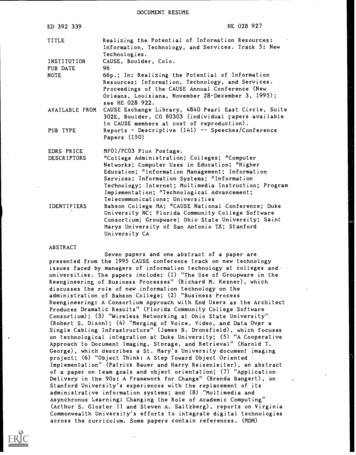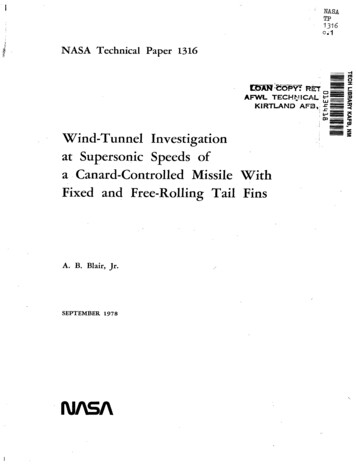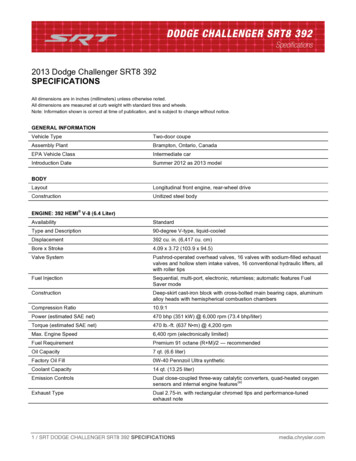
Transcription
DOCUMENT RESUMEHE 028 927ED 392 339TITLEINSTITUTIONPUB DATENOTEAVAILABLE FROMPUB TYPEEDRS PRICEDESCRIPTORSIDENTIFIERSRealizing the Potential of Information Resources:Information, Technology, and Services. Track 5: NewTechnologies.CAUSE, Boulder, Colo.9666p.; In: Realizing the Potential of InformationResources: Information, Technology, and Services.Proceedings of the CAUSE Annual Conference (NewOrleans, Louisiana, November 28-December 3, 1995);see HE 028 922.CAUSE Exchange Library, 4840 Pearl East Circle, Suite302E, Boulder, CO 80303 (individual papers availableto CAUSE members at cost of reproduction).Descriptive (141)Speeches/ConferenceReportsPapers (150)MF01/PC03 Plus Postage.*College Administration; Colleges; *ComputerNetworks; Computer Uses in Education; *HigherEducation; *Information Management; InformationServices; Information Systems; *InformationTeehnology; Internet; Multimedia Instruction; ProgramImplementation; *Technological Advancement;Telecommunications; UniversitiesBabson College MA; *CAUSE National Conference; DukeUniversity NC; Florida Community College SoftwareConsortium; Groupware; Ohio State University; SaintMarys University of San Antonio TX; StanfordUniversity CAABSTRACTSeven papers and one abstract of a paper arepresented from the 1995 CAUSE conference track on new technologyissues faced by managers of information technology at colleges and.universities. The papers include: (1) "The Use of Groupware in theReengineering of Business Processes" (Richard M. Kesner), whichdiscusses the role of new information technology on theadministration of Babson College; (2) "Business ProcessReengineering: A Consortium Approach with End Users as the ArchitectProduces Dramatic Results" (Florida Community College SoftwareConsortium); (3) "Wireless Networking at Ohio State University"(Robert S. Dixon); (4) "Merging of Voice, Video, and Data Ovpr aSingle Cabling Infrastructure" (James B. Dronsfield), which focuseson technological integration at Duke University; (5) "A CooperativeApproach to Document Imaging, Storage, and Retrieval" (Harold T.George), which describes a St. Mary's University document imagingproject; (6) "Object Think: A Step Toward Object OrientedImplementation" (Patrick Bauer and Harry Reisenleiter), an abstractof a paper on team goals and object orientation; (7) "Application.Delivery in the 90s: A Framework for Change" (Brenda Bangert), onStanford University's experiences with the replacement of itsadministrative information systems; and (8) "Multimedia andAsynchronus Learning: Changing the Role of Academic Computing"(Arthur S. Gloster II and Steven A. Saltzberg), reports on VirginiaCommonwealth University's efforts to integrate digital technologiesacross the curriculum. Some papers contain references. (MDM)
TRACK 5NEW TECHNOLOGIESCoordinator: Douglas E. HurleyRealizing the Potential ofInformation Resources:Information, Technology, and ServicesUS. DEPARTMENT OF EDUCATIONEnke of Educabonsi Research and ImprovementEDUCATIONAL RESOURCES INFORMATIONCENTER IERICI'PERMISSION TO REPRODUCE THISMATERIAL HAS BEEN GRANTED BY0 This document nal been reproduced enaed from the person or ofganuationt?twoinatineMinor changes have been made to ImproveCAUSEflproductron publityPthls of vat* or opmons staled .n In.s documant do not necessanly represent officraiOERI position or pohcy10 THE EDUCATIONAL RESOURCESINFORMATION CENTER (ERIC)."Proceedings of the1995 CAUSEAnnual Conference2
Cause 95Proceedings for Annual Conference:The Use of Groupware in the Reengineering ofBusiness Processes(to be delivered November 29, 1995)BABSONCOLLEGEprepared by:Richard M. Kesner,Chief Information OfficerBabson CollegeHorn Computer CenterBabson Park, MA 02157-0310617-239-4529 (office)617-239-6427 (fax)Kesner@Babson.eduelectronic format: Word forWindows 6.0
Groupware and Reengineering5-1-2The Use of Groupware in the Reengineering of Business ProcessesRichard M. Kesner, Chief Information OfficerBabson College, Babson Park, MassachusettsAbstract:The principles and business practices of reengineering and other changemanagement strategies have been around for decades. More recently, practitionershave stressed the central role of information resource management and informationtechnology enablement in achieving institutional reengineering objectives. Thissession takes an in the trenches" view of these efforts, considering projectmanagement, change team composition, process modeling, and the performancemetrs for both customer service enhancement and operating cost reduction. Thesession then considers in some detail the use of various collaborative I/T tools,including: electronic mail, electronic conferencing, and workflow-enablementsoftware, as an integal part of these activities.Richard M. Kesner, Chief Information Officer at Babson College and President ofRMK Associates, Inc., will begin by briefly detailing a reengincering processmodel and its I/T underpinnings. To this end, he will address the institution's needfor a formal information architecture and I/T infrastructure. With thesecapabilities in place, the institution will be positioned to move forward with amajor change initiative.Mr. Kesner will then apply this model as a lens to view Babson College'sThis case study will include a discussion of the role ofLotus Notes as a collaborative tool; Banyan Beyond Mail, Action TechnologyAction Work Flow, and Microsoft Visual Basic and SQL Server as tools fortransformation efforts.building informated and automated business processes; and ABT Power Campus,US Lan Fundmaster Financial Software, and Sequitur Admission System asworkflow-enabled applications. The following pages summarize the session'sfindings.4page - I
Groupware and ReengineeringThe Crisis in Hi her Education - the Need for Change:Many higher education leaders in the United States now believe that our collegesand universities face a major crisis. The components of this crisis are clear to usall:slow job growth and stagnant income levels.tuition growth at levels greater thai) the rate of inflation.1a rapidly growing gap between all sources of student funding and thecapacity of students and their families to pay.2a radical change in student demographics, requiring higher costs torecruit, educate, and support.a Federal financial aid structure under siege by the government forwhat it costs and criticized by the public because it does not meetcurrent need.3the more general loss of public trust in higher education.a questioning of the value and need of traeitional higher education,encouraging the growth of work place alit matives.Given these circumstances, it is clear that collegiate institutions cannot continue tooperate as they have in the past. They must change or cease to exist. According to'Operating costs and the tuition and fees continuc to rise. The mean and median undergraduate tuitionand fees at independent institutions in Massachusetts rose over 11% cach from 1991 to 1993 alone.Coupled with that, current fund cxpenditures for Massachusetts, New England, and the United States rose93%, 93%, and 89.9% respectively from 1983 to 1990 while revenues decreased 90.1%, 89.4% and 86.4%respectively. The Chronicle of Higher Education, the New York Times, and many professional journalsregularly report on thc growing gap between the cost of a college education and the ability of the typicalU.S. family to meet these financial requirements.2For example, the amount of unmet need for undergraduate students at Babson College has risen from 73,000 in 1991/2 to a projected 851,000 in 1993/4 (an increase of over 1000%). If Babson wcrc to fundthis gap, it would have an immcdiatc impact on revenues because 93% of all financial aid dollars arccurrently funded from general revenue (i.e. student tuition dollars).3Nationally, a 2 billion deficit in the Pell Grant Program has reduced the chanccs for federal aid andhence a critical component in college funding for many students. Furthermore, between 1986 and 1992,the estimated total state grant aid awarded by Massachusetts droppcd from 66,974,000 in 1986 to 39,989,000 in 1992. Here at Babson thc financial aid budget underwritten by tuition and endowmentdollars has grown by approximately 375% betmen 1986 and 1992. The College's ability to fund itsfinancial aid program in light of othcr major strategic initiatives has diminished while the student needfor financial aid has radically increased (from 32% of all undergraduates in 1989/90 to 49% today).page - 25 1 3
Groupware and Reengineering5-1-4Myles Brand, President of the University of Oregon, colleges and universities havetwo options:First, members of the academy can debate possible reforms and thencautiously pursue them, which is a tack many of us prefer. Or second, we canchallenge one another to think expansively and to debate bold new directionsin higher education - directions that break from conventional paradigms inways that range from creative to radical.4Babson College faces the same obstacles as the rest of higher education.Moreover, the College has adopted a long-range strategic plan that will rapidlypropel them into the forefront of business education. This approach has and willcontinue to require significant resources - both human and financial, far exceedingthe institution's current means.5 For example, the remaking of the Two-year MBAprogram has positioned Babson College at the leading edge. The delivery of thisprogram costs considerably more than its predecessor. Similarly, the College willneed to invest more heavily in its undergraduate program as it is redesigned.6Though both of these efforts are critical to the immediate and future viability ofBabson as an institution, neither will, in and of themselves, generate significantlyincreased revenues to cover the added costs of development, implementation, andongoing support. At another level, the College requires full-time faculty, facilities,information technologies, and library resources far beyond those thatcomplemented past modes of program delivery. These enabling services furtherraise the cost of overall operations.In quantitative terms, the College currently requires nearly an additional 1.4million dollars annually to develop and run its new educational programs. Capital,information technology, and library requirements are presently underfunded byapproximately fifty percent (50%), another 1.2 million dollars annually. Thesefigures cannot be offset by a growth in tuition and fees. In fact, to be competitivetoday, Babson is committed to annual increases in revenues pegged to theconsumer price index. Furthermore, the College plans to reduce undergraduateenrollment to approximately. 1600 by 1997/98, in line with the capacity of the4Myl,es Brand, "The Challenge to Change: 1 eforming Higher Education," Educational Record (Fall.1993): 7-13.51s/bst institutions of higher education rely twin endowment income as well as tuition dollars to covertheir operating costs. Lacking a substantial r ndowmcnt fund, Babson College must rely largely on itsannual revenues to pay for both currcnt opc,ations and future program development.6Graduate Dean Tom Moore has documcr (ed nearly a doubling in faculty contact hours in thc new MBAprogram, pushing the costs of this program beyond his limited strategic development fund. SteveSchiffman, the Undergraduate Dean. has begun thc planning for a new curriculum. It is clear from thealready-established undergraduate cluster program that anticipated undergraduate teaching changes willalso require substantial addcd resources.page - 3
Groupware and Reengineeringinstitution's present and planned facilities. In short, while essential costs are goingup dramatically, Babson lacks the ability to generate significant added revenues.Finally, since the College is dependent upon tuition dollars and will continue to beso, Babson must maintain its ability to attract and retain high quality students.While the redesign of both the graduate and undergraduate programs will addressthe academic requirements of our customers, recent data indicate that the deliverySince theseactivities are central to student perceptions of the value of the Babson experience,of student-related business services do not meet their needs.7the College must address these issues as part of its marketing and businessstrategies.Developing an Action Plan:In the spring of 1993, Babson College's President, William F. Glavin, appointed aTask Force of senior administrators, faculty, and reengineering experts to considerthe role that a reengineering process might play in the development and success ofthe institution. On December 23, 1993, this working group reported back to thePresident, recommending the initiation of a reengineering effort that focused uponthe enrollment process (i.e. the delivery of student administrative services, frominitial inquiry through graduation and including such processes as admissionprocessing, registration, student billing, and financial aid packaging). In makingthis reconiinendatin, the Task Force emphasized the goal of significantlyimproving the quality of service delivered to undergraduate and graduate students.The report indicated that this goal was to be achieved through the radical redesignof said services while reducing their overall cost to the College.On February 4, 1994 and at the recommendation of the Reengineering Task Force,President Glavin appointed a Reengineering Design Team (RDT). This groupincluded: Richard M. Kesner, Chief Information Officer, as chair; Madge Lewis,Graduate Registrar, as co-chair (and as the designated Director of thereengineering implementation process); Connie Bosse, Associate DeanUndergraduate Studies; Keith Conant, Associate Director of Financial Aid; CarolLeahy, Systems Analyst; Mary Rose, Assistant Dean of Admission; Peg Abbate,Administrative Assistant to the CIO; and Gerry Shaw, consultant (and the former7Data sources examined by thc Tas1; Force in this regard, included: Inquiry Study (July, 1988, conductedby Maguire Associates, Inc.); Quality of Lifc Study of Current Students (October, 1989, by MaguireAssociates, Inc.); Assessment of Stude.r.t Life and Student Satisfaction (April, 1993, by MaguireAssociates, Inc.); Survey of Undergraduate Recruiters and Managers (June, 1993, conducted by The Officeof Quality, Babson College); Evening MBA Service Delivery Questionnaire (April, 1993, prepared byMichael D. Cohn); A Study of Diversity (1991, Abt Associates, Inc.); Alumni Study (1991, PathfindersResearch Group); and, interviews with President's Cabinet (November, 1993, conducted by P. GerardShaw).page - 45.1.5
Groupware and ReengineeringVice President of Student Affairs at another Massachusetts college).Kesner,Lewis and Shaw were assigned to the RDT on a full-time basis, while theremainder of the team devoted approximately 40% of their time to RDT business.As set forth in the Reengineering Task Force's Case for Action and subsequentlyendorsed by the College's President and Cabinet, it was the assignment of theReengineering Design Team to develop a detailed plan for the renewed delivery ofstudent administrative services, i.e. all of those services that complementclassroom academic experiences, including: admission, financial aid, registration,student billing, student loans administration, academic planning, field-basedlearning administration, career services, and so forth. This document was topresent descriptive scenarios for a desired state, a plan for their attainment, andoperating computer system prototypes.The RDT reported back to the President and Cabinet (the College's executivemanagement team) on June 30, 1994. At a Cabinet retreat, scheduled from July 12to 14, 1994, the RDT presented its findings and demonstrated prototypes for a newstudent registration and academic planning system, a student information system, astudent financial seivices and billing system, a student opinion survey system, andan electronic course catalog.The Role of Information Resource Management (IRM):Throughout the reengineering design process, the RDT operated with anunderstanding that to succeed in this endeavor, the College required a completelynew set of information tools. The actual data was already at hand but in a widevariety of inconsistent and largely inaccessible formats. To succeed inreengineering, the College needed an VT infrastructure that afforded access toauthorized users at any time and from both on- and off-campus locations. Thecomputer hardware and software components of this solution were to facilitatebroader information access.At the start of the change process, a considerable amount of time around campuswas invested in searching for information, rekeying data already stored elsewhere,verifying the quality and accuracy of information, checking the status ofdocuments flowing within processes, and so forth. In the view of theReengineering Design Team Chair, a radically different approach was required:To address this s tuation, Babson must develop a single, integrated informationdatabase that: (1) captures all relevant customer data once, (2) allows for andindeed prompts the information owner to update and/or validate his/her records,(3) provides easy access to authorized users, (4) affords the capability to askquestions, develop scenarios, and conduct trend analysis from the data easilypage - 5
Groupwa re and Reengineering5 1 7and quickly, (5) affords multiple views of the data in its most current andaccurate form, and (6) provides access any time and from both on- and offcampus locations.The Multiple Views of the Student - to be Accessed on a "Needto-Know" Basis by Authorized Information System UsersDemographic ViewAcademic ViewFinancial ViewCo-curricular ViewCampus Residential View111External Relations ViewMedical View4141171,16.M.,1,011:W.F.,10 1.Other Views (as .Ifaaria.ficalif r10./e1raortmesumpb./.10.14As depicted above, the demographic data view would be created by the studentinitially with system-driven reminders to keep this record current. Once created,any authorized person on- or off-campus could access this demographicinformation or a portion of it to service the customer. Similarly, the academicdata view would come about as a function of information fed from automatedsystems (e.g. academic records and degree audit) as well as from actual data entry(e.g. faculty grades and advisor comments).Given the information-intensivenature of the higher education experience, each student would have many differentviews in that student's virtual (i.e. electronic) folder.Investing in Information Technology Enablement:To achieve the aforementioned information management objectives, BabsonCollege required significant changes to its I/T systems and infrastructure. Startingin 1992, the College moved towards the implementation of a state-of-the-artelectronic information network, based upon client/server technologies with theseneeds in mind. The new network (a.k.a. GlobeNet) employs an optical fiberbackbone, connecting all buildings on campus and running the Banyan Vinesoperating system. A variety of servers run both old (so-called legacy) applicationspage - 69BEST COPY AVAILABLE
Groupware and Reengineeringand new client-server-based applications via GlobeNet. On the client side of thisequation, the College has replaced old desk-top units with standard 486 personalcomputers, running Windows and the Microsoft suite of office automation tools.The overall network architecture conforms to open industry standards and willallow the College to move quickly, flexibly, and economically towards its newinformation systems and services objectives. This environment includes file andprinter sharing, an electronic mail system that works in xnjunction with itsstandard office automation tools, and cooperative groupware, such as Lotus'sNOTES and Action Technology's Action Work Flow. Furthermore, the Collegehas invested in the development of an information architecture as forward thinkingas its network design.Globenet FeaturesFile Servers-trz- -1 rifiP0f40050111V.- Office Software- InformationWorkgroup SrverWorkstationsThe information architecture plan is built around a data warehouse driven by aMicrosoft SQL Server relational-database engine. At the present time, theCollege's legacy systems feed the data warehouse, but over time, new systems some purchased for their outstanding client/server performance and othersdeveloped in-house - will replace the existing transaction systems. End useraccess to College data will come less frequently from these systems and moreoften from the data warehouse via a Babson College-built front end and theemployment of off-the-shelf query tools, such as Microsoft Query.10page - 7BEST COPY AVAILABLE
Groupware and (POISE)Application 2aMS SQLServer*(BSR)Application 3(ADVANCE)r-46\InteractivewithEnd-UserApplication 4(other)* Physical copy of Data toOperational Data Store (ODS)- current data - as a subset of theData Warehouse - historical andlongitudinal data.Like the College's office automation tools, these front ends will employ an easy-touse, point-and-click, graphical user interface (GUI). Thus, all of the informationsystems will have the same look and feel, facilitating cross-functionality andtraining. Through this strategy, Babson may replace transaction systems withoutaffecting the end user's information views and business processes. Moreimportantly, as the College reengineers, it will not be restricted by the limitationsof functionally-focused information systems. The data warehouse provides theflexibility needed to fashion new information views quickly and economically asbusiness processes change.Babson's Groupware Strategy:The success of Babson's reengineering efforts depends upon the timely delivery ofeffective and efficient I/T tools. Some of these products, particularly Lotus Notesand Banyan Beyond Mail, play a critical role in the actual change managementprocess by facilitating information sharing and collaboration. Others, like ABT'sPower Campus, US Lan's Fundmaster, and Sequitur's Admission System providethe College with state-of-the-art, workflow-enabled, client-server software. Stillother products, including Microsoft's SQL Server, Access, and Visual Basic,afford both campus la specialists and end users the means to present, capture,share, and analyze information in line with the operation of reengineered businessprocesses.Thus, as part of its change management strategy, Babson has positioned itself toleverage these technologies as part of a larger information architecture plan.Simply stated, this design separates the access and operation of transaction-basedapplications from customer views of data. It also offers a powerful and efficientpage - 8IiBEST COPY AVAILABLF
Groupware and Reengineering5-1-10family of workflow-enabled products (a.k.a. middleware) toinformate andautomate processes. The following graphic summarizes this architectural design:ustomer ViewsBabson CollegeInformationArchitectureProvides addedfunctionality to theunderlying platform0Provides access toplatform servicesUnderlying platformO. servicesTransactionTransactionSystemSystemThe transaction systems at the bottom of the diagram represent products that areused, owned, and controlled by specific service providers, such as Accounting,Admission, and the Registrar. The data from these systems reaches the end user(students, faculty, and staff) via a complex middleware layer. The operationaldata store (ODS) serves as the repository for current data from transaction systemsand the data warehouse serves as its cognate historical repository.Groupware plays an integral role in the delivery systems built into this design.For example, stored procedures within the ODS and data warehouse may betriggered by specific events (e.g. the closing of an accounting period) or a specificdate (e.g. the end of registration add/drop). These triggers automatically releaseformatted data to the end user (e.g. financial reports, class rosters). At a moresophisticated level, an electronic agent or 13erformer" will look for certainconditions to exist and will then take action as governed by its program. Forexample, an agent will periodically remind faculty to submit their grades andstudents to pay their outstanding account balances. Once the faculty member orstudent has fulfill his/her obligations, the messaging will stop.t2page - 9BEST COPY AVAILABLE
Groupwa re and ReengineeringThe architecture's workflow-enabled design is most manifest in two other systemcomponents: Workview and BP Reporter. Workview is a user front-end to ActionWork Flow that lists all the work in an individual performer's work queue. TheWorkview product identifies the type of response required (a.k.a. the allowableact(s)) and the priority status of the task. This tool will allow service providers tobetter manage their daily assignments as it expedites action within businessprocesses. The BP Reporter monitors processes, service providers, and processconditions of customer satisfaction. For any given process, it identifies all activityin terms of specific performance metrics.This tool provides a graphicalrepresentation of processes team performance along with a drill-down capability toferret out the root causes of performance problems.The last major component of the Babson information architecture design iselectronic mail. We chose our e-mail product (Banyan Beyond Mail) because itpossesses both an electronic forms utility and a workflow enablement capability.Babson is integating the delivery of most information services through this tool.FileEditComposeMessageFolderRuleal Babson Information Cein Beyond Mail RemoteIn Cabinet & Presidenten Calendar and Scheduinal Campus Formsen Drafts211 Employment11.Financial ReportsInboxMainen Meetingsall Microsoft OfficeIN MIS 4500al Music 3670en Outboxen Phone CallsWindowHelp". 'sSZsk'SN' ., ssCk,AccesscfiesMailMinders Richard Kesnerz: ffichaid ik'syf6rvivas 'kV 1.ata views as well as program exreside within the start-up view of BeThe Workview and BP Reporter copal)i eswill be available on the Beyond Mail tool bar.In this manner, 2nd users need only master thee-mail system and the rudiments of MicrosoftWindows to access all of the data views, worktools, and management information that theyrequire to perform their respective jobs.In SentEn start,CD TicklerMaTraining ToolsWith Lotus Notes databases, the Babson Worldwide Web utility, and a number ofworkflow-enabled transaction system, this I/T environment is now ready for thenew business processes emerging from the College's reengineering efforts.BEST COPY AVAILABLEpage10j
BUSINESS PROCESS REENGINEERING:A CONSORTIUM APPROACHWITH END USERS AS THE ARCHITECTPRODUCES DRAMATIC RESULTSby Florida Community College Software ConsortiumTechnical Committee:Broward Community College, Roy FreemanEdison Community College, Ron JonesFlorida Community College at Jacksonville, Jack TinsleyIndian River Community College, Pat PfeifferMiami-Dade Community College, Howard MurphyOkaloosa-Walton Community College, Donna DavisPalm Beach Community College, David FrechTallahassee Community College, Carlotta ApplemanContact: Carlotta ApplemanTallahassee Community CollegeTallahasseeFloridaABSTRACTBusiness process reengineering teamed with technology produces dramatic results.Legacy software is transformed into systems, architecturally designed by users.Learn how eight Florida community colleges, which are very diverse, combinefiscal and human resources, through a consortium and vendor partnership, todevelop mission critical applications.The Consortium in partnefship with Software AG is using a Rapid ApplicationDevelopment (RAD) methodology to concurrently develop integrated Finance,Student Information, Personnel/Payroll, and Facilities systems. Specialized designteams combine the end user architect with Consortium and Software AG systemdesign experts. These baseline applications will be stored in a central repositoryand maintained by consortium teams.14
BUSINESS PROCESS REENGINEERING: A CONSORTIUMAPPROACH WITH END USERS AS THE ARCHITECT PRODUCESDRAMATIC RESULTSFLORIDA COMMUNITY COLLEGE SOFTWARE CONSORTIUMI.INTRODUCTIONA.EXISTING SITUATIONThe 1990s present a variety of critical challenges to all institutions of highereducation. Legislated mandates from both the State and Federal governmentsarrive with increasing frequency. At the same time, funding from both sources toimplement these mandates is shrinking. The demographics of the studentpopulation is changing dramatically as a decrease in the number of traditionalstudents is offset by an increase in non-traditional learners.As a res,ilt, most community colleges have been forced to find even more costeffective ways of doing business. In this rapidly changing and increasinglycomplex environment, we have come to rely on automated systems to supportmanagement decision making and to provide improved student services.Not only are new systems required, but a new way of developing and maintainingsystems is required if the Consortium is to meet the pressing challenges of today'shigher education environment. Several factors make this so:Current software systems are in place, stable, and functional, but arenearing the end of their life cycles. They are written in languagesusing design features that are out-of-date and make maintenancecomplex.Most of these applications either do not fully meet currentrequirements, or do not exist at all.Although many requirements are common to all the members of theconsortium, each member currently develops and maintains its ownsystems.The time and cost to develop new systems is excessive.B.CONSORTIUM HISTORYThe 1994 State Leislature appropriated 4.25 million to enable the communityc
Babson College. Horn Computer Center Babson Park, MA 02157-0310. 617-239-4529 (office) 617-239-6427 (fax) Kesner@Babson.edu electronic format: Word for. Windows 6.0. 5-1-2. Groupware and Reengineering. The Use of Groupware in the Reengineering of Business Processes. Richard M. Kesner, Chief Information Officer









